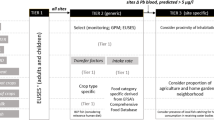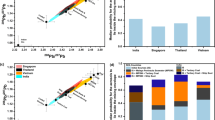Abstract
During much of the twentieth century, Jersey City, New Jersey was the leading center of chromate production in the United States. Chromate production produced huge volumes of chromium ore-processing residue containing many parts per million of hexavalent chromium. Starting in the 1990s, we undertook a series of studies to identify exposed populations, sources and pathways of exposure and the effectiveness of remediation activities in Jersey City. These studies revealed the effectiveness and success of the remediation activities. The sequence of studies presented here, builds on the lessons learned from each preceding study and illustrates how these studies advanced the field of exposure science in important ways, including the use of household dust as a measure of exposure to contaminants originating in the outdoor environment; development of effective and reproducible dust sampling; use of household dust to track temporal changes in exposure; understanding of the spatial relationship between sources of passive outdoor particulate emissions and residential exposure; use of focused biomonitoring to assess exposure under conditions of large inter-individual variability; and utility of linking environmental monitoring and biomonitoring. For chromium, the studies have demonstrated the use of Cr+6-specific analytical methods for measuring low concentrations of Cr+6 in household dust and understanding of the occurrence of Cr+6 in the background residential environment. We strongly recommend that environmental and public health agencies evaluate sites for their potential for off-site exposure and apply these tools in cases with significant potential as appropriate. This approach is especially important when contamination is widespread and/or a large population is potentially exposed. In such cases, these tools should be used to identify, characterize and then reduce the exposure to the off-site as well as on-site population. Importantly, these tools can be used in a demonstrable and quantifiable manner to provide both clarity and closure to concerned stakeholders.
This is a preview of subscription content, access via your institution
Access options
Subscribe to this journal
Receive 6 print issues and online access
$259.00 per year
only $43.17 per issue
Buy this article
- Purchase on Springer Link
- Instant access to full article PDF
Prices may be subject to local taxes which are calculated during checkout


Similar content being viewed by others
Abbreviations
- CMSP:
-
Chromium Medical Surveillance Program
- COPR:
-
chromium ore-processing residue
- EOHSI:
-
The Environmental and Occupational Health Sciences Institute
- NJDEP:
-
New Jersey Department of Environmental Protection.
References
Burke T, Fagliano J, Goldoft M, Hazen RE, Iglewicz R, McKee T . Chromite ore processing residue in Hudson County, New Jersey. Environ Health Perspect 1991; 92: 131–137.
Gochfeld M . Setting the research agenda for chromium risk assessment. Environ Health Perspect 1991; 922: 7–13.
USEPA. Integrated Risk Information System (IRIS). 2010 accessed at: http://www.epa.gov/ncea/iris/subst/0144.htm 11/4/2010.
Stern AH . A quantitative assessment of the carcinogenicity of hexavalent chromium by the oral route and its relevance to human exposure. Environ Res 2010; 110: 798–807.
Stern AH, Bagdon RE, Hazen RE, Marzulli FN . Risk assessment of the allergic dermatitis potential of environmental exposure to hexavalent chromium. J Toxicol Environ Health 1993; 40: 613–641.
Holmes AL, Wise SS, Sandwick SJ, Wise JP . The clastogenic effects of chronic exposure to particulate and soluble Cr(VI) in human lung cells. Mutat Res 2006; 610: 8–13.
Langård S . Role of chemical species and exposure characteristics in cancer among persons occupationally exposed to chromium compounds. Scand J Work Environ Health 1993; 19 (Suppl 1): 81–89.
USPHS (US Public Health Service) Gafafer WM (ed.) Health of workers in chromate producing industry. U.S. Public Health Service, Pub No 192: Washington, D.C.. 1953.
Bartlett RJ . Chromium cycling in soils and water: links, gaps, and methods. Environ Health Perspect 1991; 92: 17–24.
Katz SA . The analytical biochemistry of chromium. Environ Health Perspect 1991; 29: 13–17.
Lioy PJ, Freeman NC, Wainman T, Stern AH, Boesch R, Howell T et al Microenvironmental analysis of residential exposure to chromium-laden wastes in and around New Jersey homes. Risk Anal 1992; 12: 287–299 Erratum in: Risk Anal 12: 463.
Lioy PJ . The analysis of total human exposure for exposure assessment: a multi-discipline science for examining human contact with contaminants. Environ Sci Technol 1990; 24: 938–945.
NRC (National Research Council). Human exposure assessment for airborne pollutants: advances and opportunities. National Academy Press: Washington, D.C.. 1991.
Lioy PJ, Wainman T, Weisel C . A wipe sampler for the quantitative measurement of dust on smooth surfaces: laboratory performance studies. J Expo Anal Environ Epidemiol 1993; 3: 315–330.
Lioy PJ . Exposure science: a view of the past and milestones for the future. Environ Health Perspect 2010; 118: 1081–1090.
Stern AH, Freeman NC, Pleban P, Boesch RR, Wainman T, Howell T et al Residential exposure to chromium waste—urine biological monitoring in conjunction with environmental exposure monitoring. Environ Res 1992; 58: 147–162.
Kitsa V, Lioy PJ, Chow JC, Watson JG, Shupack S, Howell T et al Particle-size distribution of chromium: total and hexavalent chromium in inspirable, thoracic, and respirable soil particles from contaminated sites in New Jersey. Aerosol Sci Technol 1992; 17: 213–229.
Freeman NC, Wainman T, Lioy PJ, Stern AH, Shupack SI . The effect of remediation of chromium waste sites on chromium levels in urine of children living in the surrounding neighborhood. J Air Waste Manag Assoc 1995; 45: 604–614.
Lioy PJ, Burke T . Superfund: Is it safe to go home? J Expos Sci Environ Epidemiol 2010; 20: 113–114.
Fagliano JA, Savrin J, Udasin II, Gochfeld M . Community exposure and medical screening near chromium waste sites in New Jersey. Regul Toxicol Pharmacol 1997; 26: S13–S22.
Freeman NC, Hore P, Black K, Jimenez M, Sheldon L, Tulve N et al Contributions of children's activities to pesticide hand loadings following residential pesticide application. J Expo Anal Environ Epidemiol 2005; 15: 81–88.
Rhoads GG, Ettinger AS, Weisel CP, Buckley TJ, Goldman KD, Adgate J et al The effect of dust lead control on blood lead in toddlers: a randomized trial. Pediatrics 1999; 103: 551–555.
Freeman NC, Stern AH, Lioy PJ . Exposure to chromium dust from homes in a Chromium Surveillance Project. Arch Environ Health 1997; 52: 213–219.
Stern AH, Fagliano JA, Savrin JE, Freeman NC, Lioy PJ . The association of chromium in household dust with urinary chromium in residences adjacent to chromate production waste sites. Environ Health Perspect 1998; 10: 833–839.
Reed K, Jimenez M, Freeman NCG, Lioy PJ . Quantification of children’s hand and mouthing activities through a videotaping methodology. J Expos Anal Environ Epidemiol 1999; 9: 513–520.
Lanphear BP, Roughmann KJ . Pathways of lead exposure in urban children. Environ Res 1997; 74: 67–73.
Freeman NC, Lioy PJ, Stern AH . Reduction in residential chromium following site remediation. J Air Waste Manag Assoc 2000; 50: 948–953.
Stern AH, Yu CH, Black K, Lin L, Lioy PJ, Gochfeld M et al Hexavalent chromium in house dust—a comparison between an area with historic contamination from chromate production and background locations. Sci Total Environ 2010; 408: 4993–4998.
ATSDR (Agency for Toxic Substances and Disease Registry). Draft Toxicological Profile for Chromium. 2008. http://www.atsdr.cdc.gov/toxprofiles/tp7.pdf (accessed 7 January 2011).
Ruetze M, Schmitt U, Noack D, Kruse S . Untersuchungen zur mOglichen Beteiligung chromathaltiger Holzbeizen an der Entstehung von Adenokarzinomen in der NaseHolz als Roh- und Werkstoffs. 1994; 52: 87–93.
Lioy PJ, Freeman NCG, Millette JR . Dust: a metric for use in residential and building exposure assessment and source characterization. Environ Health Perspect 2002; 110: 969–983.
Ott WR, Steinemann AC, Wallace LA (eds.). Exposure Analysis. CRC-Taylor & Francis: Boca Raton, FL. 2007.
Acknowledgements
The research discussed in this manuscript is derived from a number of research projects that started in the early 1990s, with the most recent projects funded by the NJ DEP, contract no. SR06-027 for Phase I, and contract no. SR08-016 for Phase II. In addition, PJL and MG are funded under the NIEHS CEED, 2P30ES005022-21780309. We also wish to thank the many community residents and members of the municipal government who assisted us throughout this 20-year effort. Finally, we wish to dedicate this work to Dr. Natalie Freeman who passed away in 2010. It was her insights on the behavior and activities of the residents that made the major conclusions much more plausible and reduced uncertainties in post-study remediation activities. Funding: The series of studies described in this review were supported by contracts with the State of New Jersey Department of Environmental Protection and the New Jersey Department of Health and Senior Services.
Disclaimer
This paper does not necessarily reflect the policies of the New Jersey Department of Environmental Protection.
Author information
Authors and Affiliations
Corresponding author
Ethics declarations
Competing interests
The authors declare no conflict of interest.
Rights and permissions
About this article
Cite this article
Stern, A., Gochfeld, M. & Lioy, P. Two decades of exposure assessment studies on chromate production waste in Jersey City, New Jersey—what we have learned about exposure characterization and its value to public health and remediation. J Expo Sci Environ Epidemiol 23, 2–12 (2013). https://doi.org/10.1038/jes.2012.100
Received:
Accepted:
Published:
Issue Date:
DOI: https://doi.org/10.1038/jes.2012.100
Keywords
This article is cited by
-
Towards holistic technology solution to chromite ore processing residue (COPR) challenge; global issue: review and analysis
International Journal of Environmental Science and Technology (2022)
-
A post-remediation assessment in Jersey City of the association of hexavalent chromium in house dust and urinary chromium in children
Journal of Exposure Science & Environmental Epidemiology (2015)



